I’ve been using colanders and perforated pots like pond baskets for years to grow pines. They’re great for developing roots, they allow for frequent watering and they’re easy to find. What they aren’t great for are developing deciduous bonsai – at least, not without proper watering.
Most deciduous trees want a lot of water. Colanders excel at providing air to the roots.
I’ve used colanders for a variety of trees, but my biggest experiment using them for deciduous varieties has been with Chinese quince.
Chinese quince in a colander
Overall they’ve worked well, but I think more traditional pots would work better. Why? Because Chinese quince can wilt quickly in colanders.
Wilted Chinese quince
I’m currently watering my quince in colanders and pond baskets twice a day whereas my other deciduous trees need water only once a day.
A little bit of wilting isn’t always a big problem, but I find the trees that don’t wilt have healthier roots and grow faster.
Wilted quince foliage
The same shoot after watering
It could be that if I watered the trees even more frequently – 2-3 times per day in summer – and used a heavy layer of moss on the surface of the soil that the perforated pots would be fantastic for root development.
Colander – good when lots of air is beneficial
Pond basket
For people who aren’t around to water a lot, more traditional nursery containers like plastic cans or terra cotta pots might be a better option.
2-gallon nursery can
Terra cotta pots
I’m planning to transplant my quince into nursery containers this coming winter to help ensure the roots have lots of available water. I may use both terra cotta and plastic pots to see which work better, though mostly I’m looking forward to a growing season when the trees don’t wilt so easily.
Subscribe to Bonsai Tonight
New Posts Delivered Every Tuesday and Friday

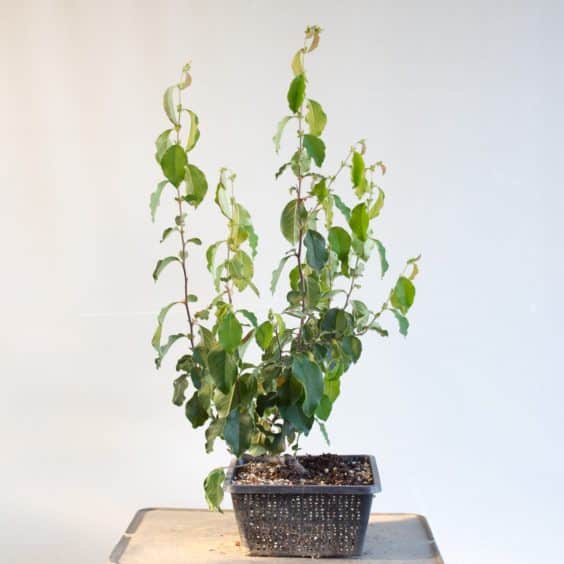
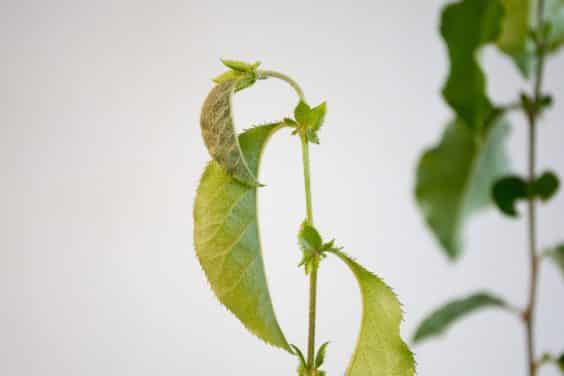
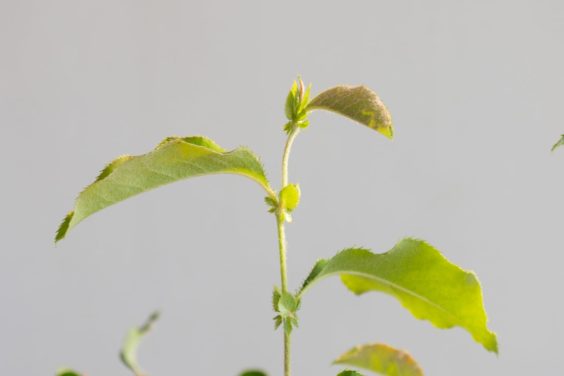
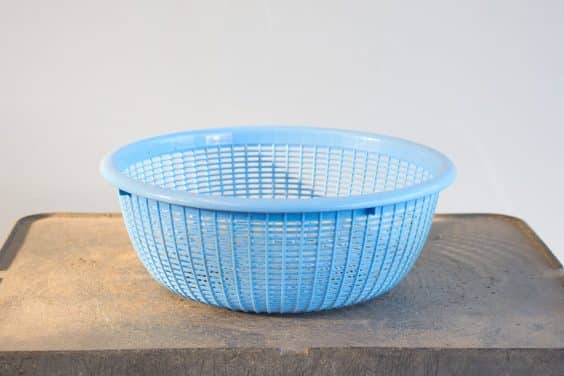
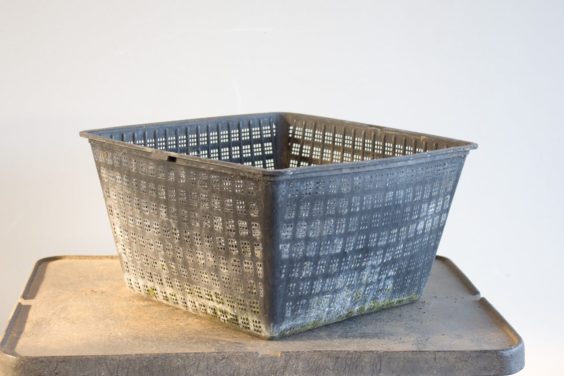
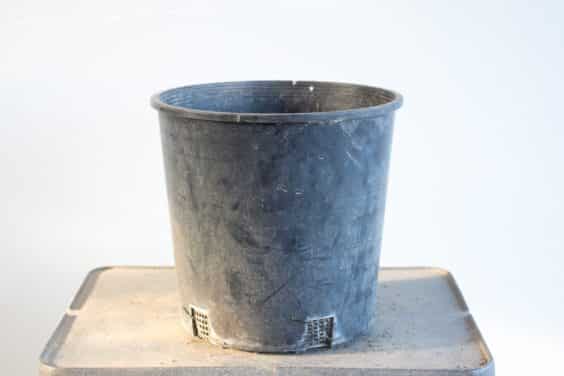
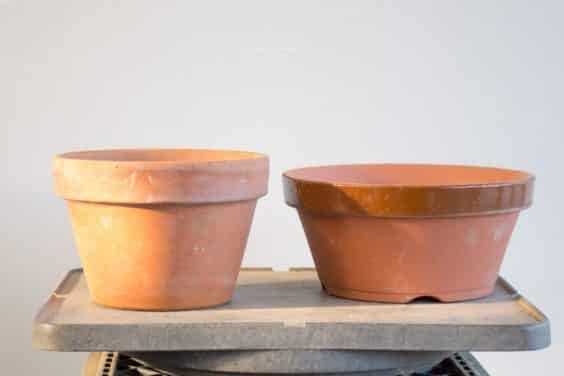
Lars Grimm says
How long have your deciduous been in the collanders/pond baskets? I haven’t noticed that problem in North Carolina where it gets plenty hot. I haven’t tried chinese quince, but no problem with japanese quince, privet, or trident maples. Usually I have to water a bunch the first few months of transplanting, but then the entire collander/pond basket fills with roots and it is no problem.
Zack Clayton says
I see a couple of variables here. How often does it rain where you are? I know some of the SE is in a drought, but not all of it. And, what is your relative humidity? With high humidity to slow evaporation, heat becomes secondary. Soil mix may be at play also. There are just so many variables.
Jonas Dupuich says
Hi Lars – as Zack noted, there are a number of variables. Our summer highs are in the low 70s with humidity between 65 and rarely above 80. We rarely get rain between May and September and it’s often breezy.
I’ve had various deciduous varieties in colanders for years with the current batch of quince in them for the past year and a half.
Lars Grimm says
Good point! We have humidity in the 80s even though temps are in the high 80’s/low 90s. We used to get rain every day in the early summer but now it is like once a week.
Gordon kelsxh says
I live in Vancouver Wa and I’m finding the same problem but with a variable. In the winter here which is oct to June sometimes longer the collandars are a godsend for both as we get an ungodly amount of rain, but this summer has been very dry and hot and I am watering 2-3 times a day or more for some. I use a well draining mix (my own version of “Boon mix”) as if I use anything less draining like turface oriented it stays too wet and oxygen starved! The deciduous trees are not producing the roots I am used to with using the collandars this year. I began using the baskets last spring instead of plastic pots to see if I could solve the too much water/oxygen starved issue in winter and it did well until this summer! Maybe it’s a 2 pot problem for me, by slipping my deciduous trees into plastic pots after the summer begins and back once it ends it will work? A lot of work though even for my small place
Jonas Dupuich says
Thanks for sharing Gordon. Another option is to place the colander or basked on or inside a larger pot that can retain more moisture. That way you don’t need to do a complete repot every season.
Tim Uy says
How about fabric pots. Do you have experience using fabric pots, or have any comments about the use of these?
Jonas Dupuich says
Hi Tim! I’ve purchased trees grown in fabric pots but haven’t used them in my garden. I think they can be good for developing stock in the ground but I don’t know how they’d do as standalone pots.
Mike says
I am using the fabric pots here in Atlanta Ga Hot and Humid all summer. Mainly maples in them and they seem to really like them. They are filling the pots well. I did some drastic root pruning this spring and used a pretty light soil mix. They were very unsteady. Now 3 months later I can lift the pot by the trunk with the roots holding on to the pot.
Tim Uy says
And using water-storing crystals or beads with fast draining mix also.
Alexander Hoffman says
OK. Not deciduous. What about white pine? I would think not. Is that right?
What species ARE colanders/pond baskets for particularly good for? Obviously, you’ve demonstrated black pines, over and over. What else do you recommend them for?
Jonas Dupuich says
Hi Alexander – good question. For the most part, I don’t recommend colanders for other varieties. Colanders are great for developing roots on pines. I’ve seen them used for exposed-root white pines in Japan, but in general I’ve mostly seen them used for black and red pines.
I think one reason for this is the emphasis on surface root quality for container grown pines.
I continue to experiment by using them for other varieties, but as of now I see the biggest benefits – at least in my climate – when using them for pines.
green says
If you are not affraid of quince taking over your garden grounding basket in soil would be an option. You gain thermal mass,all microbes and decreased need for water. Is it that said that very famous quince trees go to pretty/old potz only for the time of competition and immidietly after…back to soil? Somebody tried that before our time…
Vinny Chirayil says
Hi Jonas, multiple tree species benefit from containers offering air pruning and better root aeration, not just conifers. Sure, the watering needs might go up and need to be addressed but not at the cost of air-pruning and better aeration. Bonsai = shallow containers = more watering. It would be ironical for bonsai artists to complain about this. Rejecting colanders for deciduous trees bcos of frequent watering would be the equivalent of rejecting jet engines bcos they drink lot of fuel and instead, opting for more fuel efficient but ancient propeller engines.
The following searches will show air pruning containers being used for multi-species & give plenty of proof to clear up this misconception :
1) On youtube – how pot design affects your plant’s growth
2) On google – Swindon Bonsai Nursery Panyu Chu Kong Steel Pipe Co. Ltd
3) On google – zanna 54 flickr
4) On google – deepdale tree nursery air-pot container grown plants
5) On youtube – pomegranate bonsai from cuttings in air pruning pots (more links in the video description too)
6) pioneerpot dot com (improvement on air pruning pot design)